 |
|

|
 |
TABLE of CONTENTS
 |
Gov. Dayton signs transportation bill, funding road work for next biennium |
By Kevin Gutknecht
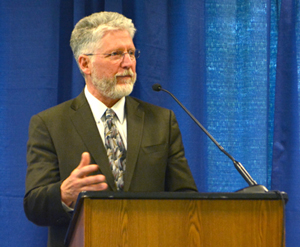
Scott Peterson, Government Affairs director, gave a recap of the transportation funding and policy bill May 19 to employees during a Meet and Greet in the Transportation Building in St. Paul. Photo by Rich Kemp |
Gov. Mark Dayton signed into law a transportation funding and policy bill that will carry MnDOT through the next biennium to support road and bridge construction and other multi-modal spending needs.
“We greatly appreciate that this bill allows MnDOT to continue its work without interruption,” said Commissioner Charlie Zelle. “We planned significant work over the next several years that is critical to the state’s transportation system.”
As part of policy changes, the new law requires that counties, cities and townships periodically retime signals on roads that carry 20,000 or more vehicles a day. MnDOT will provide technical assistance to local governments.
“Traffic congestion is an issue on those heavily used roads,” Zelle said. “This will allow better, or optimal, signal timing, which will decrease congestion, saving drivers time and fuel.”
The law also increases the penalty for second and subsequent violations of texting while driving to $225. The current fine for an initial violation is $50. The new penalty was a Department of Public Safety initiative.
The legislation does not provide any new dedicated funding for road and bridge construction. It does include a 3 percent inflationary adjustment for operations and maintenance, similar to what other state agencies received. Any spending increases will be covered by anticipated growth in the trunk highway fund.
The law also provides special, one-time appropriations in several areas, including:
- $12.5 million for a new program to provide aid to small cities, under 5,000 populations, that are not eligible for state aid road funding.
- $5 million for railroad grade crossing safety.
- An additional $2.5 million a year, for this biennium only, for Greater Minnesota transit. This will come from the general fund.
Other transportation policy changes to note include:
- Drivers will be required to move over when passing certain parked utility company vehicles that are working on roadsides. These vehicles are now included in the Move Over law passed several years ago.
- A vehicle length exemption for large commercial and recreation vehicles that use collapsible aerodynamic devices, less than five feet long, that attach to the back of the vehicle. These devices increase fuel efficiency and vehicle stability by reducing aerodynamic drag.
“While the funding provided by this bill is good news in the short-term, the future of transportation funding is still a big question,” Zelle added. “The $6 billion gap we’ve talked about for the last two years has not gone away and will only get larger if we delay addressing it.”
Read an overview of the transportation funding bill on the iHUB webpage under the Commissioner’s corner.
|
 |
|

|
 |
TABLE of CONTENTS
 |
More state highways protected with increased popularity of standing corn rows program |
By Shannon Fiecke
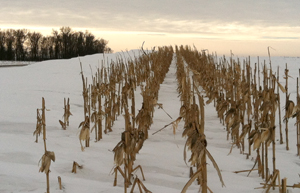
Standing corn rows hold back snow from drifting onto Hwy 111 near Nicollet. The standing corn row program lowers costs of road maintenance and improves driver visibility and road surface conditions. Photo by Gary Wyatt, University of Minnesota Extension |
As a farmer and commercial grain elevator business owner, Dave Woestehoff knows the dangers of drifting snow. So it wasn’t too difficult for District 7 snowplow driver Gene Munsterman to convince him to leave corn rows standing over the winter along Hwy 169 as a snow control measure.
“I’ve got men and their lives out on these roads every day, and I always think, hopefully, everyone makes it back tonight,” Woestehoff said. “That goes in the back of your head—what can I do to make their lives safer, because they all have families like I do.”
This past winter, MnDOT more than doubled farmer participation in its standing corn rows program, thanks to face-to-face recruitment of farmers like Woestehoff and a new tool that helps MnDOT prioritize where to invest in blowing snow control measures. The standing corn rows program is part of MnDOT’s Living Snow Fence program.
The University of Minnesota-developed tool helps MnDOT know how much to pay farmers, based on grain prices and other factors. The living snow fence payment calculator determines the cost-benefit of different snow control measures at different sites.
Knowing the value of a site and how much to offer farmers gives snowplow drivers the confidence to approach property owners along their routes.
“A year ago, before we started using the calculator, we only had about six miles of protection along highways using standing crown rows,” said Dan Gullickson, Living Snow Fence Program coordinator. “Now we have 17 miles. With this tool, we can show a district maintenance engineer the return on investment for, say a $1,000-payment per acre on a site with a blowing snow problem.”
|
This video describes the standing corn rows program and the snow control tool calculator. The calculator allows MnDOT to determine which snow control measure will be most effective on a given stretch of roadway. Video produced by Video Services |
If 40 percent of problematic sites had blowing snow control measures, Gullickson said it would save $1.3 million per year in snow removal costs. This doesn’t include the savings in terms of life and property.
“We are in an area where if you get sun on these roads and you get snow moving across and you get a glaze, it doesn’t take much to come up on a hill and hit a corner,” Woestehoff said. “It’s easy for even an experienced driver to get in the ditch.”
David Albrecht, District 7 snowplow driver, has seen 18 to 22 cars in the ditch at one time, just from the snow blowing across this portion of highway near Belle Plaine.
“This year, we’ve had about four instances with snow blowing across the road,” said Albrecht. “With the standing corn rows, I used very little salt, I had no cars in the ditch and I had very little ice out there.”
Value of corn rows
Minnesota has three areas of the state with Siberia-like conditions: south of Worthington, the Morris area and northwestern Minnesota near Hallock, Gullickson said.
In flat open areas of the state, the wind can carry as much as 70 percent of falling snow away, plugging adjacent roads and highways.
When corn stalks are left standing near the highway, they collect and block the snow from drifting onto the highway. Other snow control measures include bales of hay, planting of willow trees and artificial fences.
Using an interactive map, farmers can identify the size of snow drifts in their area and how large a snow fence needs to be.
When MnDOT established the Living Snow Fence Program 15 years ago, University of Minnesota winter climate researchers collected historical snowfall data from some 270 monitoring sites, with records going back to the 1800s in some locations. This information was entered into the cost-benefit tool.
“There are nearly 3,800 problem sites across the state and we don’t have the resources to address them all,” said Gullickson. “This tool helps us figure out the operating costs to expend additional resources to keep highways open.”
Researchers also learned that farmers don’t want to be locked into long-term contracts.
MnDOT is implementing shorter and more flexible contracts, with a flexible payment formula that accounts for varying maintenance costs, inflation of land values and crop yield.
Gullickson promoted these changes to farmers as part of a five-day Linder Farm Network tour (Linder TV interview) last year that reached more than 1,200 farmers in the corn belt region of Minnesota.
“I’d like to thank the farmers that have participated in this program,” Albrecht said. “It’s a huge benefit to us. It’s also a cost-savings for the taxpayers of this state and good for the environment.”
Read more about the Standing Corn Rows and Living Snow Fences programs at http://www.dot.state.mn.us/environment/livingsnowfence/. |
 |
|

|
 |
TABLE of CONTENTS
 |
Hwy 70 resurfacing project starts in District 1 |
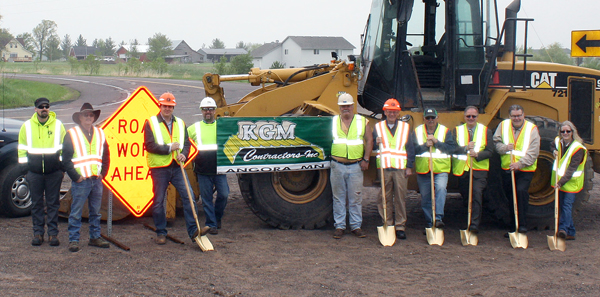
MnDOT staff and local leaders gathered for a groundbreaking ceremony May 18 for a major resurfacing and drainage improvement project on Hwy 70 in Pine County. The nine-mile-long project stretches from just east of I-35 to the Wisconsin border and will provide motorists with a safer, smoother driving surface.
“People have been waiting for a long time for this project to start,” said Duane Hill, District 1 engineer. “We’re also glad it has started. This project will improve safety with the addition of turn lanes, intersection improvements and increased sight distances.”
From left are Chris Gulan, MnDOT inspector; Dave Becker, MnDOT inspector; Dan Erickson, MnDOT project engineer; Heath Line, KGM project manager; Dan Radle, KGM foreman; Duane Hill, MnDOT District 1 engineer; Steve Hallan, Pine County commissioner; Rick Olseen, field and constituent representative for Congressman Richard Nolan; Robert Bollenbeck, east central regional district commission; and Lynn Zeleny, Highway 70 Coalition. Photo by Mn/DOT Photographer |
|
 |
|

|
 |
TABLE of CONTENTS
 |
Safety campaigns target work zones, pedestrians |
By Sue Roe
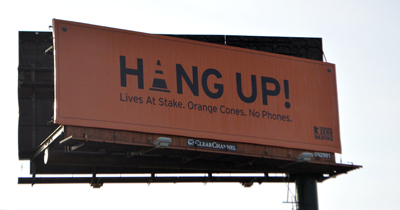
This billboard on I-94 in St. Paul is one of many around the state reminding motorists to hang up their phones and pay attention when driving in work zones. Speeding and inattentive driving are the two most common causes of work zone crashes. Photo by Rich Kemp |
Two statewide public education safety campaigns remind motorists and pedestrians to be safe as they drive and walk. The Office of Traffic, Safety and Technology’s $600,000 work zone and pedestrian campaigns include billboards, radio spots and transit bus signs. Funding for the campaigns is from the Federal Highway Administration and the State Trunk Highway Fund.
The work zone safety campaign features the message- Hang Up! Lives at Stake. Orange Cones. No Phones.- as a reminder for motorists to hang up their phones and pay attention when driving in work zones.
“Drivers face many distractions under the best of conditions and driving through construction work zones only amplifies distractions with lane changes and other unexpected variations,” said Kristine Hernandez, statewide TZD coordinator. “We hope this campaign helps raise awareness and makes people realize that driving is already multi-tasking, especially in a work zone.”
The billboards are located near some of the more than 300 work zones around the state this spring and summer.
The campaign is part of the Toward Zero Deaths program, a multi-agency partnership that uses education, enforcement, engineering, and emergency trauma response to promote safe and smart driving behavior.
The TZD program started in 2003 by MnDOT and the departments of health and public safety. The effort helped decrease roadway fatalities by nearly half, from 655 in 2003 to 361 in 2014.
The pedestrian safety campaign features safe behavior messages for drivers and walkers. The billboard, radio and bus transit messages include Stop for pedestrians at every corner and Distracted walking is dangerous walking.
“Crash data show pedestrians, motorists and bicyclists are all equally responsible for safety. Educating and encouraging safe driving, walking and biking behaviors helps make Minnesota roads safer for everyone,” said Melissa Barnes, pedestrian and bicycle safety engineer.
The billboards are located in high traffic areas in several cities around the state.
For tips for staying safe in highway work zones, see www.mndot.gov/workzone/. For more information about pedestrian safety, see www.mndot.gov/sharetheroad/ped. |
 |
|

|
|

|
 |
TABLE of CONTENTS
 |
Library, ERGs to host open house June 2 |
By Karen Neinstadt, Research Services and Library Employees are invited to visit the MnDOT Library at Central Office on June 2 from 11 a.m. to 2 p.m. to learn about the library and Employee Resource Groups.
The library is partnering with ERGs to engage, inform and educate colleagues about available resources and how they can help employees.
ERGs help MnDOT create an inclusive workplace culture that builds on the unique perspectives and strengths of employees to the benefit of all.
“This event showcases the seven active ERGs,” said Mary Young, Affirmative Action Office. “These groups are composed of interested members and allies that work to support professional development, recruitment, retention, and community outreach. Employees can learn how they can become involved or start their own ERG.”
Visitors will have the opportunity to participate in activities, browse the collection, view displays, speak with ERG representatives, and enjoy light refreshments.
District employees can participate remotely by completing an online quiz on the library website and submitting their responses by web form or to library.dot@state.mn.us. The quiz will only be active from 11 a.m. to 2 p.m. on June 2.
For more information, contact Karen Neinstadt at 651-366-3796 or Mary Young at 651-366-4716 or Mary.Young@state.mn.us.
Employee Resource Group events:
- June 2 – Joint Library/ERG Open House
- June 10 – Spectrum lunch and learn (managing and supervising people with Autism Spectrum Disorder)
- June 24 – Q & A ERG (LGBT 101 lunch and learn)
- June 27-28 – Q & A ERG – Pride Parade and booth at Pride Festival
-
To help at the MnDOT booth (June 27-28) or march in the parade June 28, contact Bruce Tanquist.
- Aug. 12 – Spectrum Brown Bag (Family members with ASD)
|
|
 |
|

|
|

|
|

|
 |
TABLE of CONTENTS
 |
The value of safety…for all of us |
By Katie Fleming, Office of Traffic, Safety and Technology This summer, my oldest daughter will begin driving. I can picture the first time she makes a solo trip on the road. I remind her to drive safely, wear her seat belt, not to use the phone, and not to allow any passengers in the car. Really, I want to tell those around her to drive safely.
Sometimes I consider spray-painting a big message on the car, “DRIVE SAFE AROUND MY CHILD!” I don’t think I am alone in this feeling. We all want to tell other road users to make safe choices around our family, friends and coworkers. We want Minnesota road users to value safety. We want Minnesota to have a positive traffic safety culture.
TRAFFIC SAFETY CULTURE is the shared values, beliefs, norms, and attitudes that influence attitudes and behaviors related to traffic safety. This includes the expectations and acceptance of efforts by traffic safety agencies. |
While traffic safety culture may be a new concept to some of us, safety culture strategies have promoted healthy and safe communities for years. Decades ago, the public viewed impaired driving as a minor infraction. Today, impaired driving is socially unacceptable. This change was due to several safety culture strategies. Education and prevention campaigns targeted all age groups and across multiple areas of life – family, friends, community, and the nation. Even Hollywood mentioned designated drivers on popular television programs. Workplaces adopted no drinking and driving policies and communities began to recognize the real cost of impaired driving. Impaired driving became a national concern.
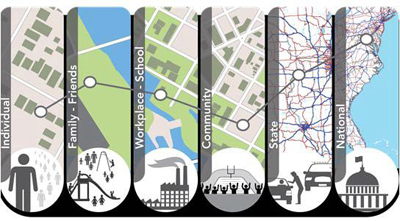
Each area of our life has influence on our values. Effective traffic safety culture strategies are present across all areas of life. |
Most traditional safety strategies are effective for the location and time period in which they are present. For example, a speed bump has no impact on travel speeds 10 blocks away. Traffic enforcement waves promote safer driving, but only for the period in which officers are present. While effective, these strategies require resources and are not sustainable across an entire network.
A positive traffic safety culture means road users value safety, recognize their role in promoting safe roadways, and share a concern for other road users. It means communities desire traffic safety countermeasures, such as roundabouts and rumble strips. A positive traffic safety culture can help us do our work more efficiently.
In 2012, MnDOT funded an innovative research project, Measuring Minnesota’s Traffic Safety Culture. This study found that Minnesotans value their families and have a desire to protect them. The Embrace Life public safety message is a prime example of positive ways to link protecting family with traffic safety. The social sciences tell us we are heavily influenced by what we believe others expect of us and what others do. This study found that Minnesotans who believe most people frequently speed by 10 mph over the speed limit are 10 times more likely to speed frequently. The good news is strategies, such as positive social norming, effectively address this issue.
Positive social norming campaigns promote appropriate behavior and demonstrate that certain unsafe behavior is actually in the minority. The recommendations from this project can serve as a guide for future safety programing for MnDOT and our partners.
MnDOT’s partners care about traffic safety culture. As part of the process to update the Minnesota Strategic Highway Safety Plan, the Office of Traffic, Safety and Technology gathered input from more than 500 of MnDOT’s transportation safety stakeholders. This input guided the revision of the Minnesota Strategic Highway Safety Plan. Traffic safety culture was an overwhelming theme among our stakeholders, and the SHSP steering committee placed traffic safety culture as a central focus area in Minnesota.
MnDOT is a committed and involved Minnesota Toward Zero Deaths partner. Traffic deaths and serious injuries among family, friends and coworkers should never be an acceptable cost of doing business, so why not for all of Minnesotans? We want drivers who share the roads with our friends and coworkers to value safety, and we want drivers who share the roads with our family and children to value safety. We also want drivers who travel through our work zones to value safety. Achieving a positive traffic safety culture requires leadership, diligence and patience, but it is within our reach.
|
 |
|
______________________________________________________________________________ -->
| |
|



